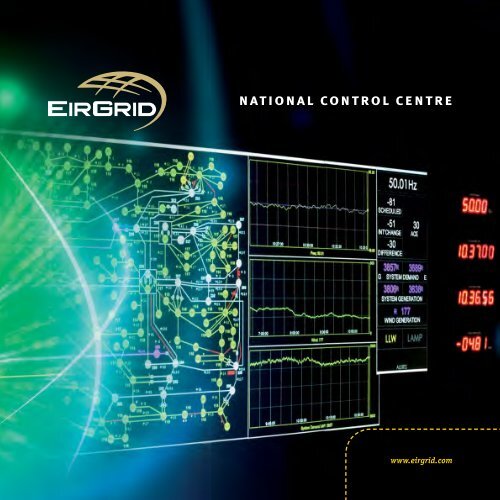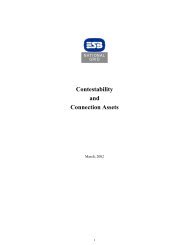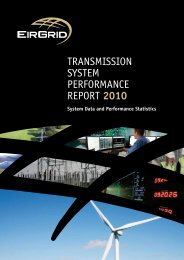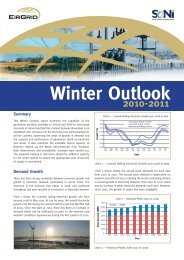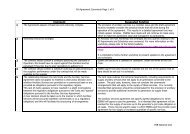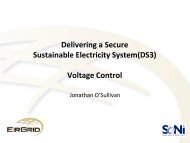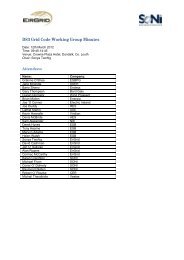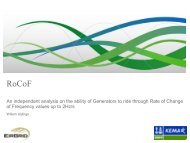national control centre - Eirgrid
national control centre - Eirgrid
national control centre - Eirgrid
You also want an ePaper? Increase the reach of your titles
YUMPU automatically turns print PDFs into web optimized ePapers that Google loves.
<strong>national</strong> <strong>control</strong> <strong>centre</strong>www.eirgrid.com
SYSTEM LOAD CURVESmega-watts (mw)510050004900480047004600450044004300420041004000390038003700360035003400330032003100300029002800270026002500240023002200210020001900180000:00:00 06:00:0012:00:00 18:00:00 00:00:00quarter-hour time intervals■ 18 December 2007 ■ 3 August 2008
EirGridEirGrid plc is the independent electricity TransmissionSystem Operator (TSO) in Ireland and the Market Operatorin the wholesale electricity trading system. EirGrid's role isto deliver services to generators, suppliers and customersacross the high voltage electricity system, and to put in placethe grid infrastructure needed to support Ireland's economy.EirGrid develops, maintains and operates a safe, secure,reliable, economical and efficient transmission system.Electricity is an essential and convenient service providedto two million electricity consumers, including domesticcustomers, small and medium industry, farms and agribusiness,and large high-technology industrial customers.This illustrates the vital nature of the service EirGrid provides.The Power SystemThe power system comprises major generation stationsand windfarms, the transmission grid and the distributionsystem. The transmission system is operated at the voltagelevels of 400kV, 220kV and 110kV. An analogy could bemade with the road system. The 400kV system could belikened to the major inter-urban motorways, the 220kVsystem to the dual carriageways and the 110kV system tothe <strong>national</strong> road serving every country and linking town.4%11%6%SUMMARY OF TRANSMISSION PLANTstationsroute(km approx)400kV 3 450220kV 19 180018%TYPICALFUEL MIX6%110kV 81 400055%gascoalchprenewablespeatoil
The National Control Centre (NCC)The system is operated from EirGrid’s National ControlCentre (NCC) in its role as Transmission System Operator.Critical to the work in the EirGrid NCC are all generators,the Hydro-Electric Control Centre in Turlough Hill and thetwo Distribution Control Centres (DCCs) which are operatedby ESB.The EirGrid NCC is located in Dublin and exercises energymanagement functions over the generation and transmissionsystem. The DCCs are located at the major load <strong>centre</strong>s ofDublin and Cork and have responsibility for distribution ofpower within their regions. Distribution networks are at amedium and lower voltage and link most customers to theNational Grid.On 27th April 1995 the system was interconnected withthe Northern Ireland system via two 275/220kV links. Thesystem in Northern Ireland is operated by SONI, the SystemOperator for Northern Ireland. The advent of the SingleElectricity Market on the island in November 2007 hasemphasised the requirement for, and major advantages of,close co-operation in the running of the power systems inboth jurisdictions.The NCC was opened in April 1987 and replaced in 2004.Previous to the NCC, there had been a <strong>centre</strong> called theLoad Dispatch Office (LDO), which had carried out similar,but not identical roles.This was superseded by the NCC, which introduced ITtechnology, replacing previous systems which involvedtelephone contacts between station operators and <strong>control</strong><strong>centre</strong> personnel.The objective of the NCC is to operate the generation andtransmission system for maximum economy, consistent withsafety, security, continuity, quality and environmentalstandards. It provides high quality delivery to all customers,through maintaining this essential service, 24 hours a day,every day of the year.In the minute-to-minute operation of the system, continualmonitoring is necessary. To facilitate this, the NCC requires asubstantial quantity of on-line information. This informationis collected by remote terminal units (RTUs) which arelocated in each transmission station around Ireland andwhich transmit the information to the NCC computer system.There is also a simulator in the NCC which enablesinstructors to provide challenging scenarios for trainingpurposes in a real-time environment. Operators are allhighly-trained engineers with extensive periods workingalongside experienced grid <strong>control</strong>lers and certificationprocesses, prior to assignment to the NCC.
Operation of the Generation System– second by secondThe basic generation function of the NCC is to ensureenough generation is produced to meet customer demand.This function must be carried out in a fair and transparentmanner while the supply-demand balance must bemaintained on an instantaneous basis in order to keep thefrequency of the system at 50Hz. The NCC engineersschedule which generation will be required throughout theday. This generation mix is influenced by the SingleElectricity Market (SEM). The NCC engineers must also allowfor unforeseen events, such as a greater demand thanexpected or the loss of a generator from the system, ordamage to a piece of equipment on the system.Unusual events – such as football matches – createchanges in the operation of the system because the demanddoes not follow normal patterns. When one million peopleswitch on their kettles at half-time, the combined effect is asignificant increase in demand. NCC engineers are aware ofthe need to be prepared for these events, as well as othernormal fluctuations in demand on a daily or seasonal basis.Forecasting electricity demand during the day or year canutilise the fact that normally demand follows the patternof similar conditions on the same day in previous years.For instance, winter demand adopts the following patternnormally: demand reaches its lowest level, or trough, inthe early hours of the morning, before rising sharply as thepopulation wakens. It then rises again over the lunchtimeperiod, and finally increases to its winter evening peak,due to lighting, heating and cooking needs of consumersreturning home. In summertime, demand is far lower anddue to brighter conditions in the evening, the daily peakis at lunchtime, rather than during the evening.
Operation of the Transmission SystemThe purpose of the transmission system is to transfer bulkpower from generators to load <strong>centre</strong>s. The transfer is doneat high voltages to minimise transmission losses. The<strong>control</strong> engineers’ function is to ensure that voltages andflows on the system are within limits at all times. Systemstability and safety of the public and those working on thesystem are key priorities. Significant changes in demandwill cause the voltage to change and the frequency tochange, so these are monitored constantly.Changes in demand for power <strong>national</strong>ly, therefore,need to be anticipated and timely action taken. This isprimarily done by continually monitoring and <strong>control</strong>linggenerators’ production and managing the topology of thetransmission system.Stormy weather can create problems on the transmissionsystem. High winds and, in particular lightning, can causechallenging conditions. The <strong>control</strong> engineers must quicklydecipher what has happened and act swiftly. In most cases,this is done without any consumer being affected, butmajor incidents can affect customers and the priority is torestore the network as quickly as possible in a safe manner.A lightning detection system is available to the <strong>control</strong>engineers to assist with operating the system during storms,and Met Eireann is contracted to provide special alerts toand forecasts to the NCC in relation to weather events.The engineers must be prepared to deal with allunforeseen events. To assist them in this regard they havepowerful software tools such as Contingency Analysis,Loadflow and State Estimation programmes.


